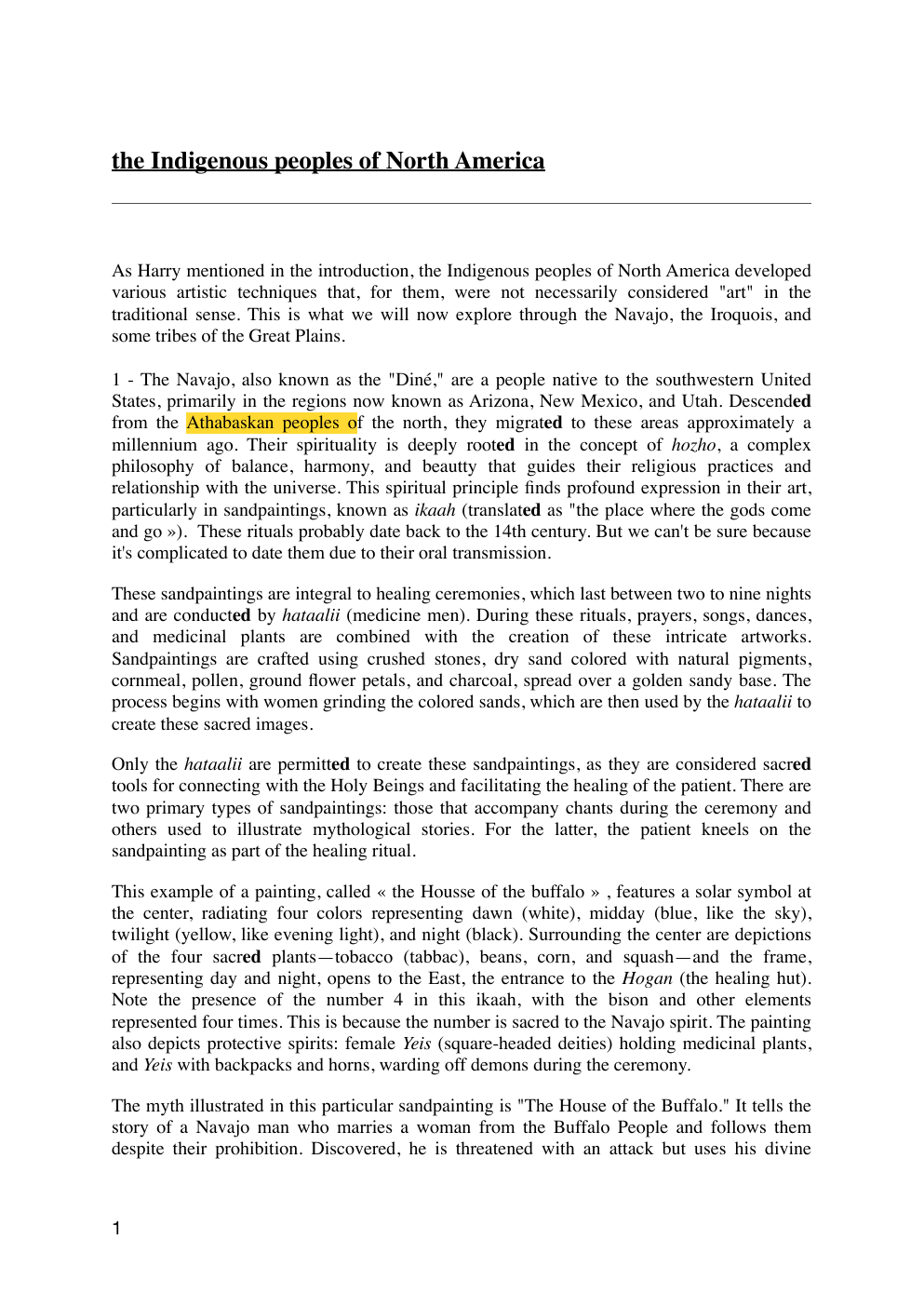the Indigenous peoples of North America
Publié le 05/02/2025
Extrait du document
«
the Indigenous peoples of North America
As Harry mentioned in the introduction, the Indigenous peoples of North America developed
various artistic techniques that, for them, were not necessarily considered "art" in the
traditional sense.
This is what we will now explore through the Navajo, the Iroquois, and
some tribes of the Great Plains.
1 - The Navajo, also known as the "Diné," are a people native to the southwestern United
States, primarily in the regions now known as Arizona, New Mexico, and Utah.
Descended
from the Athabaskan peoples of the north, they migrated to these areas approximately a
millennium ago.
Their spirituality is deeply rooted in the concept of hozho, a complex
philosophy of balance, harmony, and beautty that guides their religious practices and
relationship with the universe.
This spiritual principle nds profound expression in their art,
particularly in sandpaintings, known as ikaah (translated as "the place where the gods come
and go »).
These rituals probably date back to the 14th century.
But we can't be sure because
it's complicated to date them due to their oral transmission.
These sandpaintings are integral to healing ceremonies, which last between two to nine nights
and are conducted by hataalii (medicine men).
During these rituals, prayers, songs, dances,
and medicinal plants are combined with the creation of these intricate artworks.
Sandpaintings are crafted using crushed stones, dry sand colored with natural pigments,
cornmeal, pollen, ground ower petals, and charcoal, spread over a golden sandy base.
The
process begins with women grinding the colored sands, which are then used by the hataalii to
create these sacred images.
Only the hataalii are permitted to create these sandpaintings, as they are considered sacred
tools for connecting with the Holy Beings and facilitating the healing of the patient.
There are
two primary types of sandpaintings: those that accompany chants during the ceremony and
others used to illustrate mythological stories.
For the latter, the patient kneels on the
sandpainting as part of the healing ritual.
This example of a painting, called « the Housse of the buffalo » , features a solar symbol at
the center, radiating four colors representing dawn (white), midday (blue, like the sky),
twilight (yellow, like evening light), and night (black).
Surrounding the center are depictions
of the four sacred plants—tobacco (tabbac), beans, corn, and squash—and the frame,
representing day and night, opens to the East, the entrance to the Hogan (the healing hut).
Note the presence of the number 4 in this ikaah, with the bison and other elements
represented four times.
This is because the number is sacred to the Navajo spirit.
The painting
also depicts protective spirits: female Yeis (square-headed deities) holding medicinal plants,
and Yeis with backpacks and horns, warding off demons during the ceremony.
The myth illustrated in this particular sandpainting is "The House of the Buffalo." It tells....
»
↓↓↓ APERÇU DU DOCUMENT ↓↓↓
Liens utiles
- Louisiana Purchase TreatyIn 1803 the United States purchased a vast interior region of North America from France for $15 million.
- The United States of America (2)
- Gulf of Tonkin Resolution (text of resolution)In August 1964 North Vietnamese boats fired on an American destroyer in the Gulf of Tonkin.
- Hanif Kureishi - The Buddha of Suburbia
- does the end justifies the means


